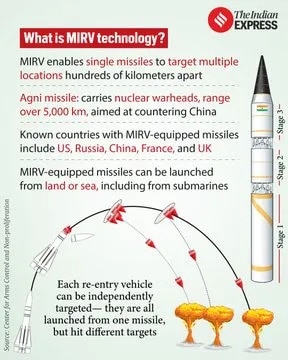Take a look at the essential events, concepts, terms, quotes, or phenomena every day and brush up your knowledge. Here’s your knowledge nugget for today.
Knowledge nugget: Storm Shadow & Oreshnik
Subject: International Relations & Defence Technology
(Relevance: The Ukraine-Russia war has been hitting the news headlines often. The UPSC has previously asked questions on various aspects related to this ongoing conflict. In this context, understanding the unique weapons and their usage influencing the war dynamics becomes crucial. Additionally, defence technology is an integral part of the UPSC CSE syllabus.)

Why in the news?
Recently, the Ukraine-Russia war took a significant turn when Kyiv deployed British-made Storm Shadow missiles against military targets within Russia. This attack followed the historic use of US-provided Army Tactical Missile System (ATACMS) missiles on Russian territory, which had been authorized by President Joe Biden.
In retaliation, Russia launched a hypersonic intermediate-range ballistic missile (IRBM) known as “Oreshnik” at the Ukrainian city of Dnipro on Thursday.
Key Takeaways :
1. For months, Kyiv has been urging its Western allies to supply long-range weapons that can strike deep into Russian-controlled territories. In this regard, the use of Storm Shadow missiles and ATACMS missiles by Ukraine represents a significant development in the ongoing war.
2. Recently, Russian military bloggers on Telegram also shared images of alleged Storm Shadow missile fragments found near Marino, a village in Kursk. Local governor Alexei Smirnov claimed that Russian air defenses intercepted two missiles. In response to the attack, Ukraine’s air force official Yuriy Ignat alluded to the incident, stating there had been a “strong storm” in the Kursk region.
Storm Shadow
1. Storm Shadow is a long-ranged, air-launched, conventionally armed, deep-strike cruise missile. It is developed by the UK and France. It can travel up to 250 kilometers (155 miles) and is designed to destroy tough targets like bunkers and ammunition storage.
Story continues below this ad
2. It weighs 1,300 kg and is 5.10m long. It’s capable of being operated day and night in all weathers and designed to destroy high-valued stationary targets such as airbases, radar installations, communications hubs and port facilities. The report by Airforce Technology mentioned that what makes this missile a stealthy weapon is the combination of its long-range, low altitude and supersonic speed.
 Storm Shadow cruise missile. (AP photo)
Storm Shadow cruise missile. (AP photo)
3. Equipped with the fire-and-forget technology, Storm Shadow, also offers high precision deep strike capability as it features a sophisticated navigation system that includes inertial navigation (INS), global positioning system (GPS) and terrain reference navigation for better control over the path.
4. The missile features the BROACH (Bomb Royal Ordnance Augmented CHarge) warhead — a high-technology warhead, which first cuts the surface of the target, penetrates into it and then explodes. Storm Shadow is operated by Eurofighter Typhoon, Rafale, Mirage 2000 and Tornado.
ATACMS
1. Russia also alleged that debris from a US-made Army Tactical Missile System (ATACMS) has fallen in the Bryansk region of the country.
2. Notably, weeks before leaving the White House, Joe Biden provided authorisation to Kyiv to use the ATACMS, inside Russia.
Story continues below this ad
 ATACMS missiles are fired from the HIMARS and MLRS M270 platforms, which have been provided earlier to Ukraine by the US and the United Kingdom respectively. (Via Lockheed Martin website)
ATACMS missiles are fired from the HIMARS and MLRS M270 platforms, which have been provided earlier to Ukraine by the US and the United Kingdom respectively. (Via Lockheed Martin website)
3. ATACMS is a surface-to-surface ballistic missile capable of hitting targets at up to 300km (186 miles). This range means that Ukraine may now be able to hit targets inside Russia, including Russian-annexed Crimea.
4. The missiles are fuelled by solid rocket propellant and follow a ballistic path into the atmosphere before coming back down at a high speed and high angle, making them difficult to intercept.
‘Oreshnik’ Missiles
1. The Ukraine Air Force initially claimed that Russia launched an intercontinental ballistic missile (ICBM), which is nuclear-capable and has longer ranges than intermediate-range ballistic missiles (IRBMs). This assertion was quickly disproven.
2. Russia confirmed that it launched an experimental intermediate-range ballistic missile. Putin referred to the missile as ‘Oreshnik’ (the hazel). In addition to the “Oreshnik” missile, Russia deployed a Kinzhal hypersonic missile and several cruise missiles during the attack.
Story continues below this ad
3. Ukraine’s Security Service showed The Associated Press on Sunday wreckage of the new experimental ballistic missile, which struck a factory in the central Ukrainian city of Dnipro.
4. The fragments of the Oreshnik, which the Pentagon said is based on Russia’s RS-26 Rubezh intercontinental ballistic missile -– have not been analyzed yet.
5. According to Western sources, the missile fired by Russia boasts a range of as much as 5,500 km, enough to effectively target every European city from Russian territory.
 The fragments of the missile Oreshnik. (Reuters)
The fragments of the missile Oreshnik. (Reuters)
BEYOND THE NUGGET: India successfully flight-tested a long-range hypersonic missile
1. India is considered among the top few nations when it comes to designing and developing missiles indigenously, although it is way behind the US, China and Russia in terms of range.
Story continues below this ad
2. In a major boost to its military prowess, India has successfully flight-tested a long-range hypersonic missile off the coast of Odisha, which was developed by the Defence Research and Development Organisation (DRDO).
3. It is designed to carry various payloads for ranges greater than 1,500 km. The term “Hypersonic” refers to a speed at least five times the speed of sound (also called Mach-5).
4. The two types of hypersonic weapons systems are Hypersonic Glide Vehicles (HGV) and Hypersonic Cruise Missiles. The HGVs are launched from a rocket before gliding to the intended target while HCMs are powered by air-breathing high-speed engines or ‘scramjets’ after acquiring their target.
Story continues below this ad
(Sources: Storm Shadow cruise missiles to Ukraine, India successfully test-fires long-range hypersonic missile, What are Storm Shadow missiles?, Roundup of world news this week)
For your queries and suggestions write at roshni.yadav@indianexpress.com
Subscribe to our UPSC newsletter and stay updated with the news cues from the past week.
Stay updated with the latest UPSC articles by joining our Telegram channel – Indian Express UPSC Hub, and follow us on Instagram and X.
Story continues below this ad



 Storm Shadow cruise missile. (AP photo)
Storm Shadow cruise missile. (AP photo) ATACMS missiles are fired from the HIMARS and MLRS M270 platforms, which have been provided earlier to Ukraine by the US and the United Kingdom respectively. (Via Lockheed Martin website)
ATACMS missiles are fired from the HIMARS and MLRS M270 platforms, which have been provided earlier to Ukraine by the US and the United Kingdom respectively. (Via Lockheed Martin website) The fragments of the missile Oreshnik. (Reuters)
The fragments of the missile Oreshnik. (Reuters)































